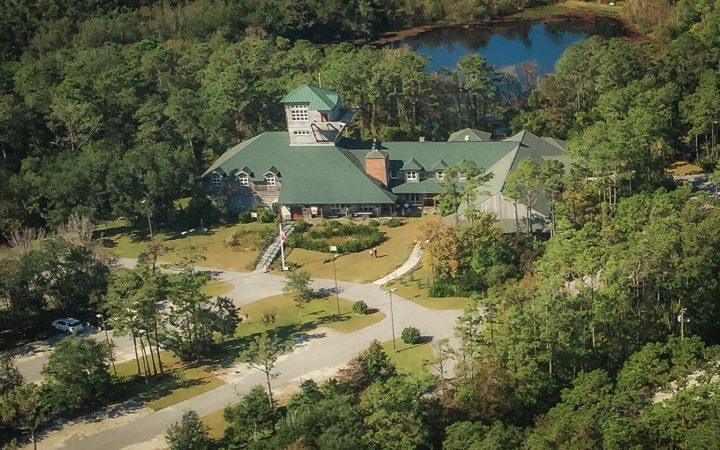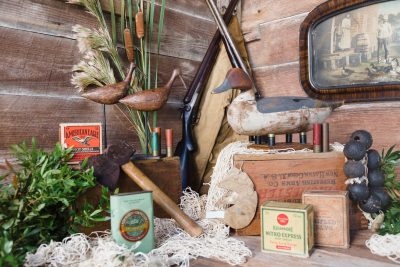
HARKERS ISLAND – For the past 25 years, the Core Sound Waterfowl Museum and Heritage Center has made its focus those who call Down East home.
Those long-remembered names that have been woven into local lore as well as the volunteers and staff who have spent tireless hours doing any and everything from spending the day frying seafood in a hot kitchen to chasing down memorabilia for an exhibit have been commemorated with the museum’s 25th anniversary documentary, “Core Sound’s Place,” that will be shown in its entirety for the first time during the annual Taste of Core Sound summer edition. The museum also hosts a Taste of Core Sound each winter.
Supporter Spotlight

Set for Friday, Aug. 25, the Taste of Core Sound summer edition will feature a spread of scallop fritters, baked flounder, seafood casserole, chicken and pastry, fresh wahoo salad, shrimp salad, collards, sweet potatoes, squash casserole, fresh tomatoes and cucumbers, light rolls and fig cake that will be served at 7 p.m., before the documentary is shown at 8 p.m. Doors will open at 6 p.m., when wine and cheese will be available.
Tickets are $50 per person for museum members and $65 for non-members. There will also be a raffle that night, giving ticketholders a chance to win a golf cart, 100 pounds of fresh shrimp, a Yeti Hopper 30 cooler or gift certificates to restaurants and shops across Carteret County. Tickets are $20 each or six for $100.
Karen Willis Amspacher, museum director, explained that the documentary is more of a scrapbook of all the people who have been part of the 25-year journey.
“The goal of the documentary was to bring together the voices of those who have been leaders in this work,” she said.
“Our question to them was ‘Why?’ What brought you to this project and what has caused you to invest so much of yourself in this effort for Down East?,” she said. “There were lots more questions of course, but essentially, Why? This museum is a story of people … People who care about their community – past, present and future … and that is relayed in these conversations.”
Supporter Spotlight
Filmmakers Ryan Stancil and Baxter Miller were tasked with condensing the past 25 years of museum history into a 25-minute film. They spent months interviewing folks who have had an impact on the museum, filtering through archives and listening to oral histories collected over the decades.
“It is an impossible task but they have captured the spirit of this museum and the heritage it preserves, documents and shares,” Amspacher added.
“Yes, it is an incredible building with an impressive collection and excellent programming but at the end of the day, it is the people and their shared dedication to their heritage and history that has made the museum a success and such an important resource for the region and North Carolina. It’s their voices that tell the story,” Miller said.
There are a range of voices that have contributed to the success of the museum that were recorded for the documentary, including that of Carteret County storyteller Connie Mason; Core Sound Decoy Carvers Guild founding president Wayne Davis; volunteer membership secretary Margaret Goodwin; decoy carver Lionel Gilgo; North Carolina Arts Council director Wayne Martin; Kathryn Chadwick, the granddaughter of founding chair, the late Billy Smith; historian and author David Cecelski; and county historian Rodney Kemp.
Echoing throughout the film is the sentiment that it’s the people who make the museum.
“I’ve always said that Down East is not so much the place, it’s the people. And to me the people are the hidden treasure of Down East, North Carolina, and the Core Sound waterfowl Museum highlights the people and what they are and who they are, so I think it plays a vital mission to understanding who we are,” Mason said in the film.
Cecelski is quoted in the film as saying that the museum is one of the handful of most important museums in the country.

“And yes, the museum does very professional exhibits and they’re a first-class museum, but what’s really extraordinary about them is a way that they’re redefining what a museum is … So, it’s a museum, but half the time it’s more like church and it’s a space for homecoming and reunion and for connecting the generations. You know you couldn’t have a museum any closer to the people and the place.”
Martin of the state’s Arts Council said the office of folklife programs began collaborating with the waterfowl museum.
“I was just struck. I was struck by the fact that of all the groups I was working with, there were two groups that felt so strongly about place – the connection of place to culture. One was the eastern band of Cherokee. The other was Core Sound and Harkers Island and those communities Down East,” he said.
Martin continued by explaining that they realize that the dirt and the water and the trees and the flora and the fauna shape who they are as people and that they, in turn, have shaped those resources and utilized those resources and to some extent changed them. Adding that the fact that everything grew out of that philosophy of being connected to the land and place today’s world is so rare.
“To find communities that understand how important it is to honor that concept and, in a sense, stay true to it so that your identity remains connected to that very spot on the earth or in North Carolina.”
Kemp has a long history with the museum and spends many hours a year there leading programs, including one he created, Community Nights. One night a month, a community is highlighted following a potluck dinner.
“You’re talking love now. You’re talking love of saltwater. You’re talking love of water everywhere. You’re talking about the breezes, the ones that freezes us in winter, and cools us in the summer. And the people,” Kemp said about the museum. “The people are unbelievable. And I don’t just mean Down East, all of Carteret County, those that are native Carteret County that were raised here are loving people that will give you what you need in a time, good friends, very good friends.”
The granddaughter of founding chairman the late Billy Smith, Chadwick has many generations tied to the museum. She said that she thinks that the museum is an anchor to what they want the future generations to be able to see.
“We were excited that there was going to be a museum. … I think everybody was proud to see it break ground and I know my grandmother was very happy to see the gallery completed … that was probably the highlight of the museum for her, was to actually know that the building was complete and everything was how she you know if everyone had envisioned it. The dream had become true.”








